7 Best Power Banks for Wild Camping.
7 Best Power Banks for Wild Camping. This phrase alone sparks the spirit of adventure. It promises rugged hills, quiet forests, and starry night skies. Yet it also raises questions of power. How do you keep devices charged off the grid? Indeed, a reliable power source in the wild becomes essential. In this article, we will dive deep into the 7 Best Power Banks for Wild Camping, explaining each option in more detail and offering practical insights to help you choose the right model.
Table of Contents
Introduction: The Rising Need for Power in Remote Places
Nature beckons us toward towering mountains and hidden valleys. Yet, we rely heavily on technology to stay safe and connected. Our phones track hikes, serve as cameras, and store maps. Our GPS devices guide us. Meanwhile, our torches and lamps illuminate a dark campsite. Consequently, power has become a non-negotiable companion.
The demand for quality charging solutions continues to grow. These solutions bridge the gap between wilderness and the digital world. That is why many campers now search for the 7 Best Power Banks for Wild Camping. They crave tools that ensure their gear remains charged during extended excursions. Moreover, the best power banks offer not just battery life but also durability, weather resistance, and portability.
Hence, we must choose carefully. After all, these power banks will endure rough trails and sudden temperature changes. Some may get splashed by rain or banged against a rock. Shorter weekend trips may need only moderate charging capacity, whereas longer expeditions often demand bigger, more rugged chargers. We must weigh each option wisely.
Now, let’s dive deeper into the 7 Best Power Banks for Wild Camping. We’ll highlight their unique features, compare their advantages, and show how each can serve your outdoor preferences.
1. Anker PowerCore 26800:
The Anker PowerCore 26800 appears among the 7 Best Power Banks for Wild Camping primarily because of its high-capacity 26,800mAh lithium-ion battery. This capacity translates to multiple full charges for modern smartphones—often six to eight charges, depending on your phone’s battery. Three USB output ports enable you to recharge several devices simultaneously, making it a go-to option for group camping or for individuals with multiple gadgets.
Beyond capacity, durability is key. The Anker PowerCore 26800 features a robust casing that handles minor drops or bumps. While not fully waterproof, it withstands gentle splashes if you’re careful with it. Many campers appreciate its reliable performance in varying temperatures, though extremely cold conditions can diminish battery efficiency.
Pros
- Large 26,800mAh capacity (ideal for multi-day trips)
- Supports simultaneous charging with three USB ports
- Renowned for reliability and strong customer support
- Durable casing to protect against minor impacts
Cons
- On the heavier side compared to lower-capacity banks
- Not waterproof or dustproof
Approximate Weight: ~490 grams (17.3 oz)
Typical Recharge Time: Around 10-11 hours from empty to full (using a standard wall charger)
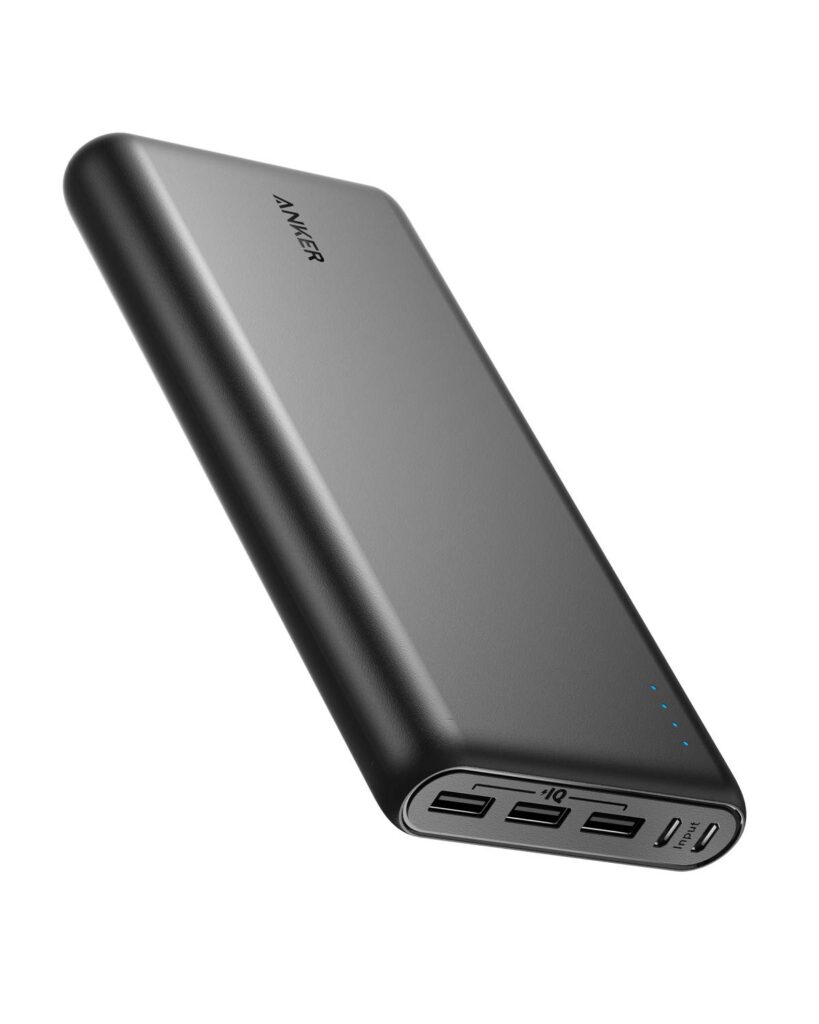
2. RAVPower Portable Charger 20000mAh: Among the 7 Best Power Banks for Wild Camping
RAVPower’s 20,000mAh Portable Charger strikes an attractive balance between capacity and portability. Capable of roughly five or more full phone charges, it meets the needs of campers on weekend getaways or moderate-length trips. With two USB output ports, you can power multiple devices at once—perfect for sharing with a friend or keeping your phone and headlamp topped off simultaneously.
A key advantage of this model is its relatively quick recharge time. Under optimal conditions, you can replenish the battery in 6-7 hours. The charger also integrates various safety protections, including safeguards against overvoltage and short circuits.
Pros
- 20,000mAh capacity supports several full phone charges
- Dual USB outputs for simultaneous charging
- Comparatively faster recharge than bigger-capacity models
- Balanced size and weight for moderate treks
Cons
- Not entirely weatherproof (best stored in a dry pouch)
- Still heavier than ultra-compact banks
Approximate Weight: ~400 grams (14.1 oz)
Typical Recharge Time: About 6-7 hours
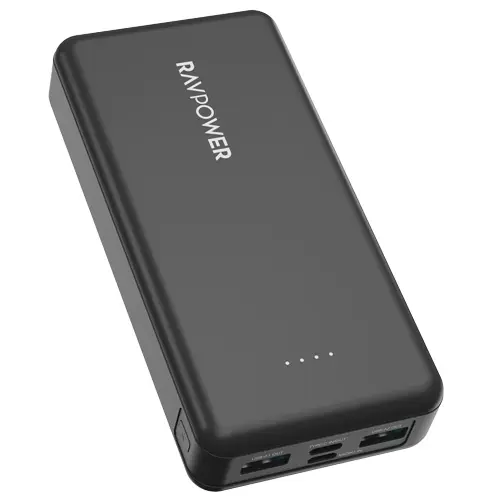
3. Goal Zero Venture 30: Rugged Choice Among the 7 Best Power Banks for Wild Camping
The Goal Zero Venture 30 is renowned for its rugged build and moderate 7,800mAh capacity. While 7,800mAh translates to roughly two or three phone charges, its real strength lies in durability. A shock-resistant casing and water-resistant port covers protect against dust, mud, and light rain—ideal for campers prone to encountering rough trails.
Another standout feature is its compatibility with solar panels, allowing you to harness sunlight in extended off-grid scenarios. Although sunshine can be hit-or-miss, a few hours of daylight each day can stretch your device usage for longer trips.
Pros
- Protective casing handles drops and light splashes
- Designed for seamless use with solar panels
- Relatively compact and easy to pack
- Fast recharge when connected to a solid power source
Cons
- 7,800mAh capacity is lower than other options
- Not fully waterproof if fully submerged
Approximate Weight: ~250 grams (8.8 oz)
Typical Recharge Time: ~4 hours from a wall charger (longer if relying on solar alone)

4. BioLite Charge 80 PD: High-Capacity Marvel in the 7 Best Power Banks for Wild Camping
Designed by a brand well-versed in off-grid innovation, the BioLite Charge 80 PD boasts a hefty 20,000mAh capacity and fast-charging USB-C Power Delivery. This means you can top off modern devices in less time than with a basic USB port. Expect four or more phone charges, depending on usage.
BioLite’s ethos centers on sustainable, eco-friendly design. While the Charge 80 PD isn’t fully waterproof, it does feature a sturdy build that handles mild splashes and bumps. Pairing it with a foldable solar panel can extend your self-reliance on multi-day treks.
Pros
- 20,000mAh battery with USB-C PD for speedy charging
- Handles small splashes and moderate impacts
- Fits well with BioLite’s eco-friendly product range
- Good option for rapid device charging on the trail
Cons
- Heavier than some alternatives
- Lacks full waterproofing
Approximate Weight: ~450–500 grams (1 lb+)
Typical Recharge Time: ~7-8 hours via USB-C PD
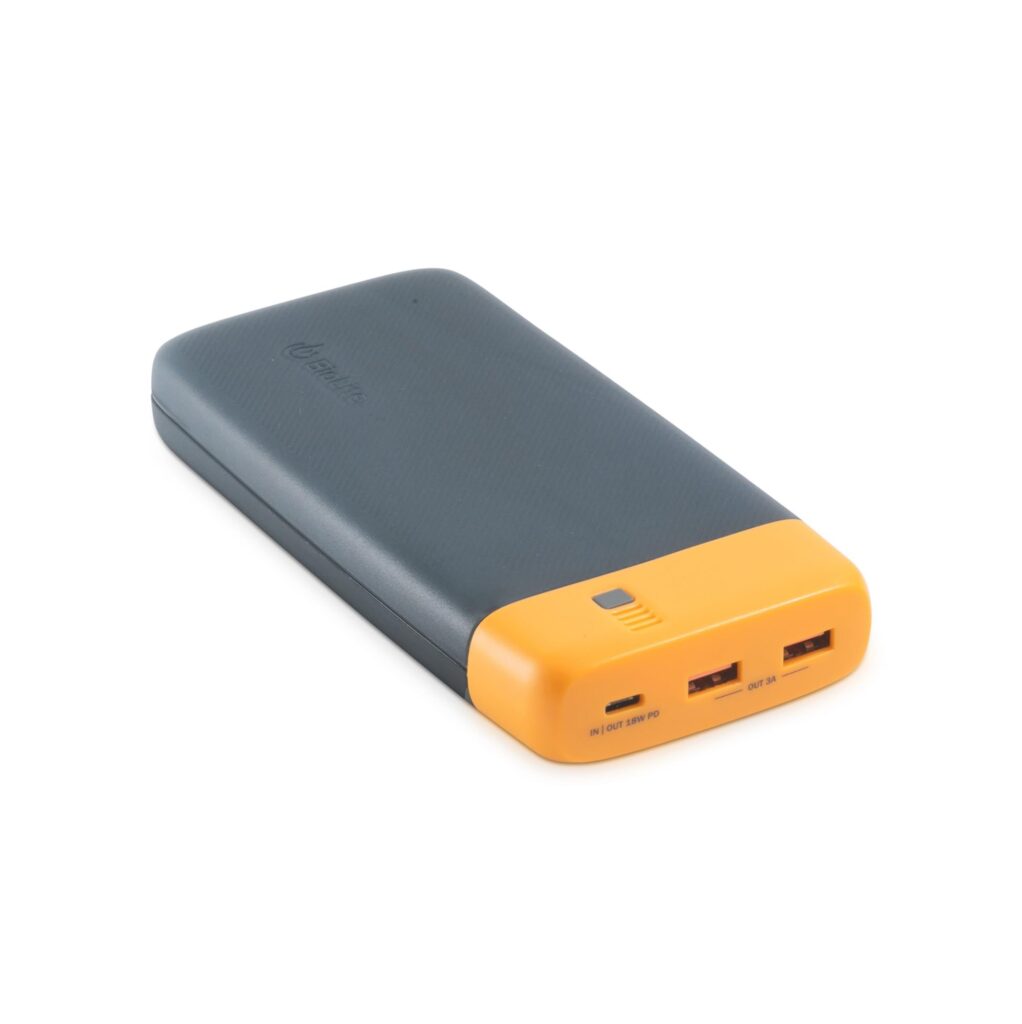
5. BigBlue 28W Solar Charger: Solar Companion
While not technically a power bank, the BigBlue 28W Solar Charger is a valuable companion for campers who want an on-the-go charging option. It pairs best with a separate battery pack, allowing you to top up devices in daylight. This panel includes multiple outputs, letting you charge a phone and a backup battery at the same time if the sun cooperates.
Car campers and long-stay adventurers often appreciate this, especially in sunnier climates. In the UK’s fickle weather, you may not get a full charge every day, but a few hours of direct sunlight can still offset some battery drain. The panel folds down for easier transport, though it’s bulkier than a standalone power bank.
Pros
- Robust 28W output for fast solar charging
- Folds compactly for easier carrying
- Versatile approach to recharging off-grid
- Can power devices directly or feed a separate battery pack
Cons
- Not a battery by itself; requires a separate power bank
- Dependent on sunlight availability
- Bulkier than traditional chargers

Approximate Weight: ~600–650 grams (1.3–1.4 lb)
Typical Recharge Time: Varies widely by weather conditions (2–6 hours of strong sunlight may partially recharge a typical battery pack)
6. Nitecore NB10000: Ultralight Star
Beloved by ultralight backpackers, the Nitecore NB10000 weighs an impressively low ~150 grams while still providing a 10,000mAh capacity. This is typically enough for two to three phone charges. The carbon fiber construction not only reduces weight but adds a degree of resilience, though it isn’t fully waterproof.
A highlight is its USB-C port with fast charging capabilities. For hikers who prioritize minimal pack weight, the NB10000 is a top contender. Keep it in a protective sack or pouch to guard against moisture or rough handling.
Pros
- Extremely lightweight (~150 grams)
- 10,000mAh capacity with fast USB-C charging
- Carbon fiber design for durability
- Great for weight-conscious backpackers
Cons
- Less total capacity than bigger banks
- Not weatherproof; needs careful storage
Approximate Weight: ~150 grams (5.3 oz)
Typical Recharge Time: ~4-5 hours, depending on charger output
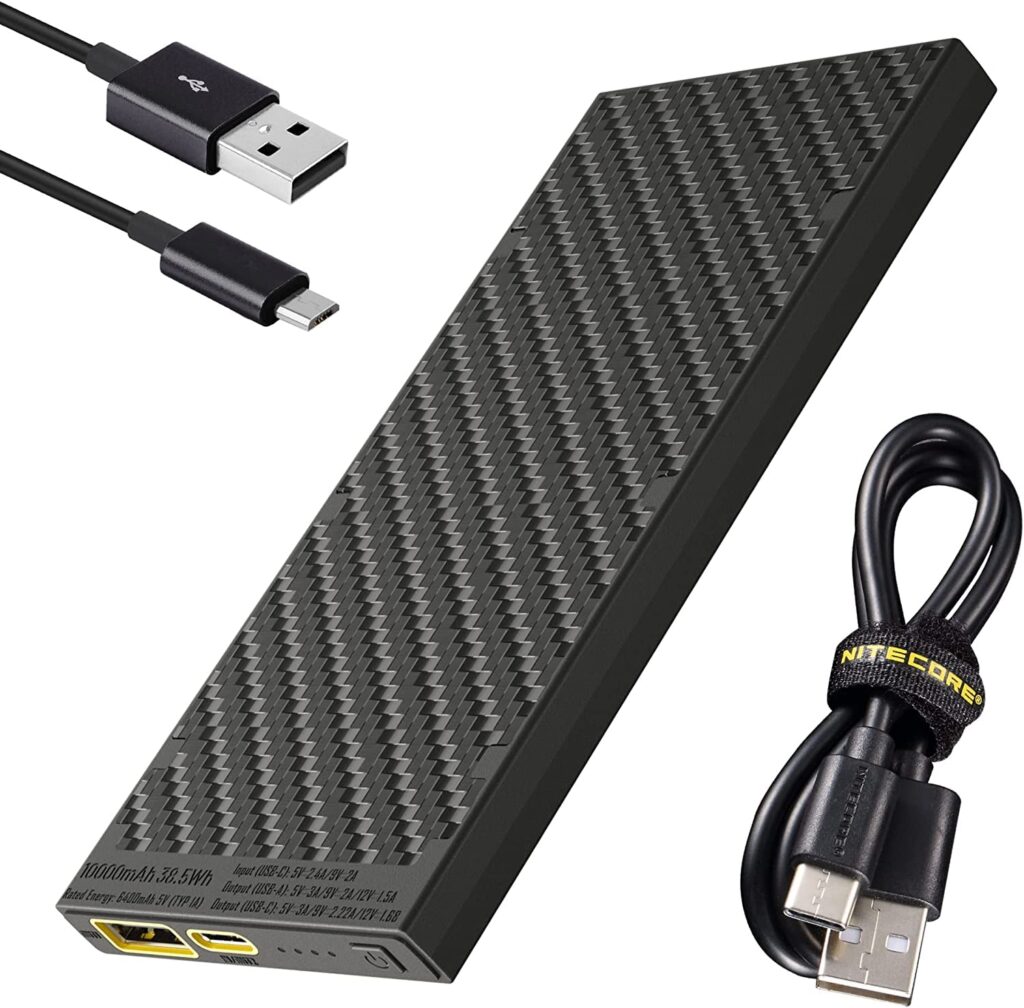
7. AsperX Portable Charger: Budget-Friendly Option in the 7 Best Power Banks for Wild Camping
If you’re looking for an affordable yet robust solution, consider the AsperX Portable Charger. Boasting up to 26,800mAh capacity (depending on the variant), this device can keep most smartphones powered for multiple charges, making it highly reliable for extended camping trips. It also offers pass-through charging, letting you power your devices while the charger itself is replenishing. Additionally, built-in safety features protect against overcharging and voltage spikes. While not fully waterproof, it can handle minor bumps or knocks if stored carefully and kept away from heavy rain. Overall, the AsperX Portable Charger strikes a fine balance between capacity, affordability, and user-friendly design—perfect for adventurers seeking confidence in their power supply throughout multi-day wilderness excursions.
Pros
- High capacity (up to 26,800mAh) for several phone charges
- Budget-friendly price
- Simple, compact design
- Good balance of size and capacity
Cons
- Not fully weatherproof
- May be heavier than lower-capacity alternatives
Approximate Weight: ~350–400 grams (varies by model)
Typical Recharge Time: ~10–12 hours (depending on charger output)
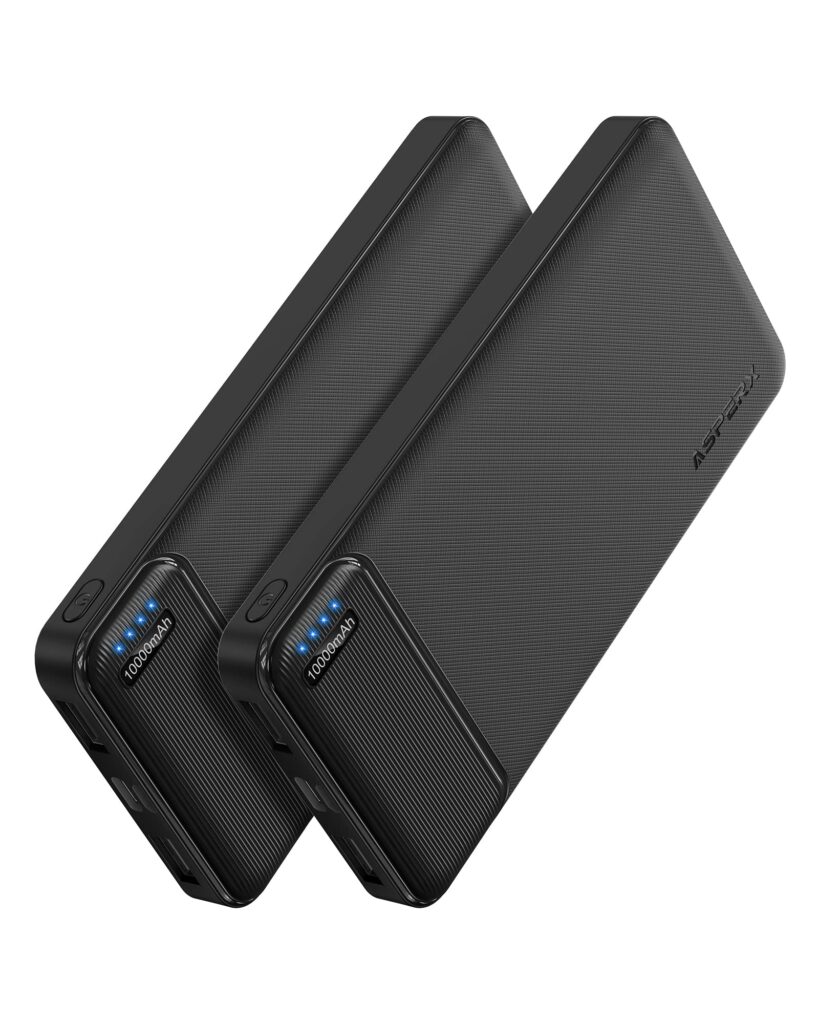
Practical Advice for Using the 7 Best Power Banks for Wild Camping in the Field
- Use Low Power or Airplane Mode: Reduce background activity on your devices to conserve battery.
- Efficient Charging Schedules: If you can access a café or lodge with electricity, charge both your power bank and phone at once.
- Cable Care: A frayed cable can hinder performance. Keep cables in a protective bag to avoid damage.
- Temperature Considerations: Cold weather drains batteries faster. Store your power bank in a warm place or inside your sleeping bag at night.
- Partial Recharges: Lithium-ion batteries last longer if maintained above 20% and below 80%.
- Angle Solar Panels: Even minor adjustments can boost energy intake on sunny days.
Conclusion: Maximizing Your Adventures
We’ve covered an array of options, from large-capacity bricks to ultra-light solutions. Each stands out for reliability and overall performance in the outdoors. Some cater to sheer durability, others to portability, but all aim to keep your devices powered in remote locations.
Finally, remember that protecting your power bank prolongs its lifespan. Use dry bags or protective cases in rainy or snowy weather, and keep the device warm in freezing conditions. Planning well-timed recharges at any available plug can also spare you from dead-battery emergencies.
Best Place to Purchase
For convenience and variety, Amazon often proves the best choice for purchasing these power banks. Its extensive selection lets you compare prices, read user reviews, and enjoy speedy delivery. Plus, Amazon’s hassle-free return policy adds peace of mind. By securing your power solution in advance, you’ll be well-prepared for any wild camping adventure.
Embark on your journey with a fully charged setup, and stay powered through every twist and turn nature throws your way. Safe travels, and happy exploring!

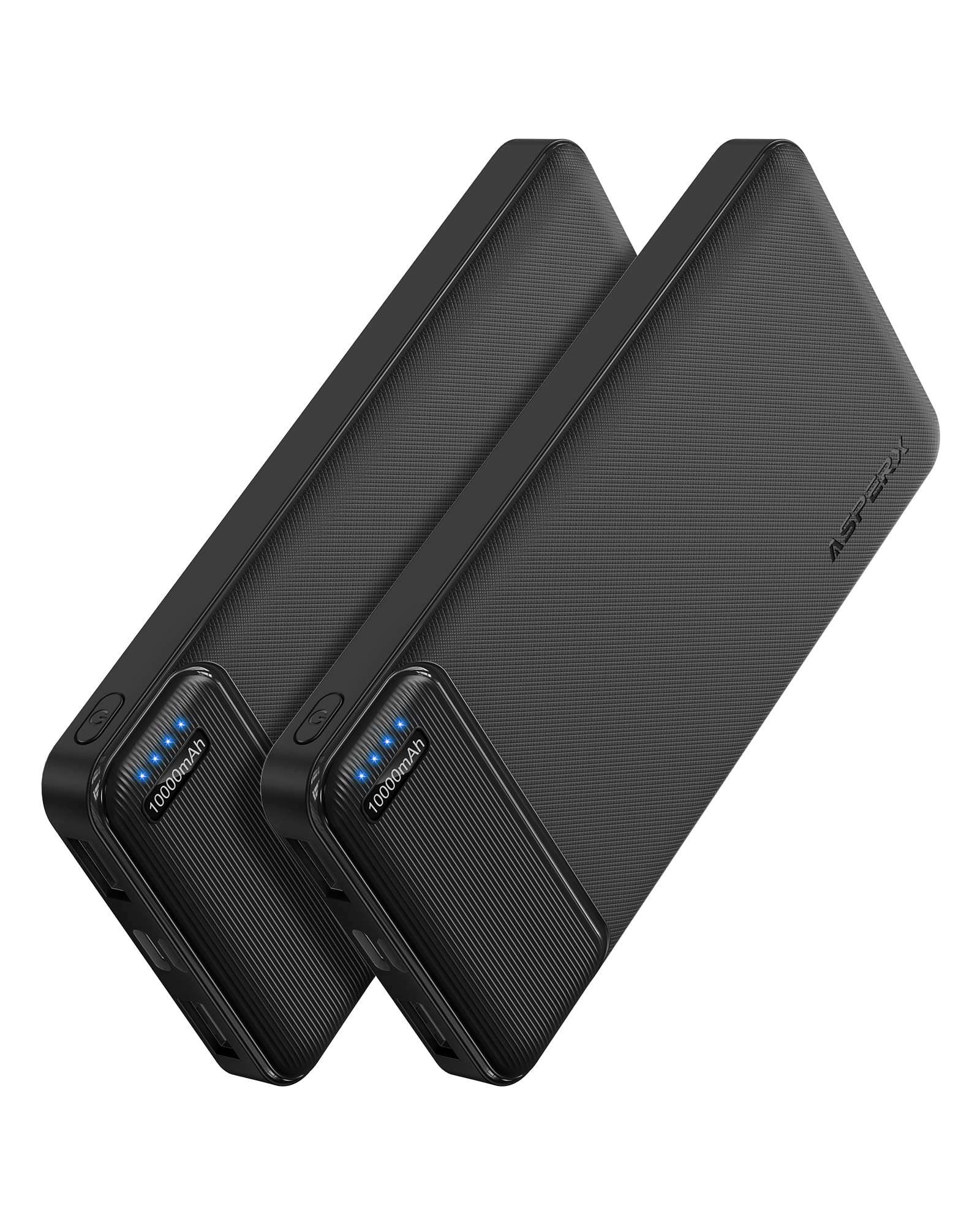





![BigBlue Portable 25W Solar Charger [Pocket-Size], Folding Solar Panel with USB-A and USB-C Ports, IP68 Waterproof Solar Panel for Backpacking Compatible with Cellphones, Tablets, Power Bank](https://m.media-amazon.com/images/I/413u-strRsL.jpg)


